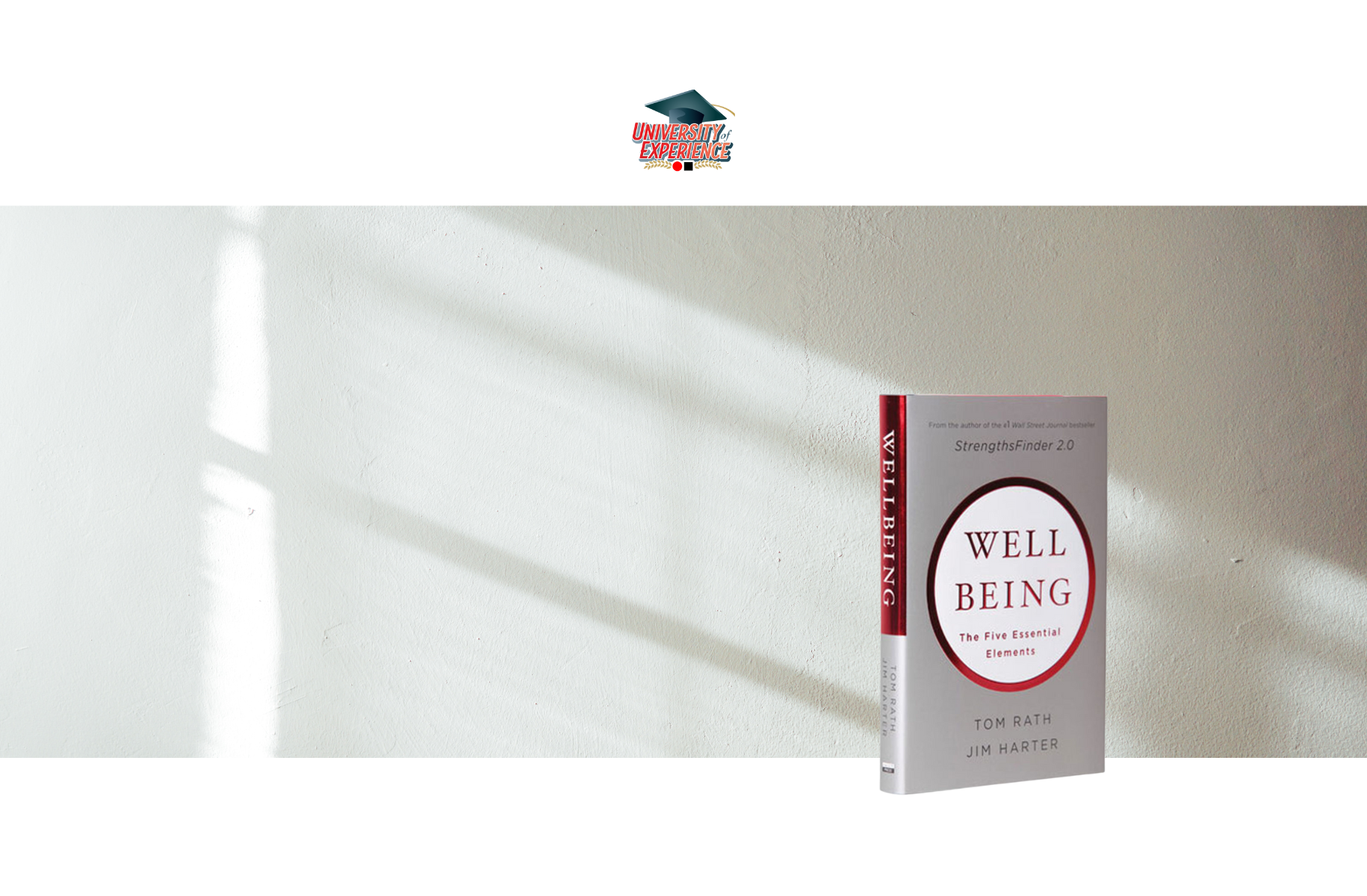By Manuel “Bobby” Orig, Director, ApoAgua
WELLBEING
THE FIVE ESSENTIAL ELEMENTS THAT MAKE LIVES WORTHWHILE
By TOM RATH and JIM HARTER
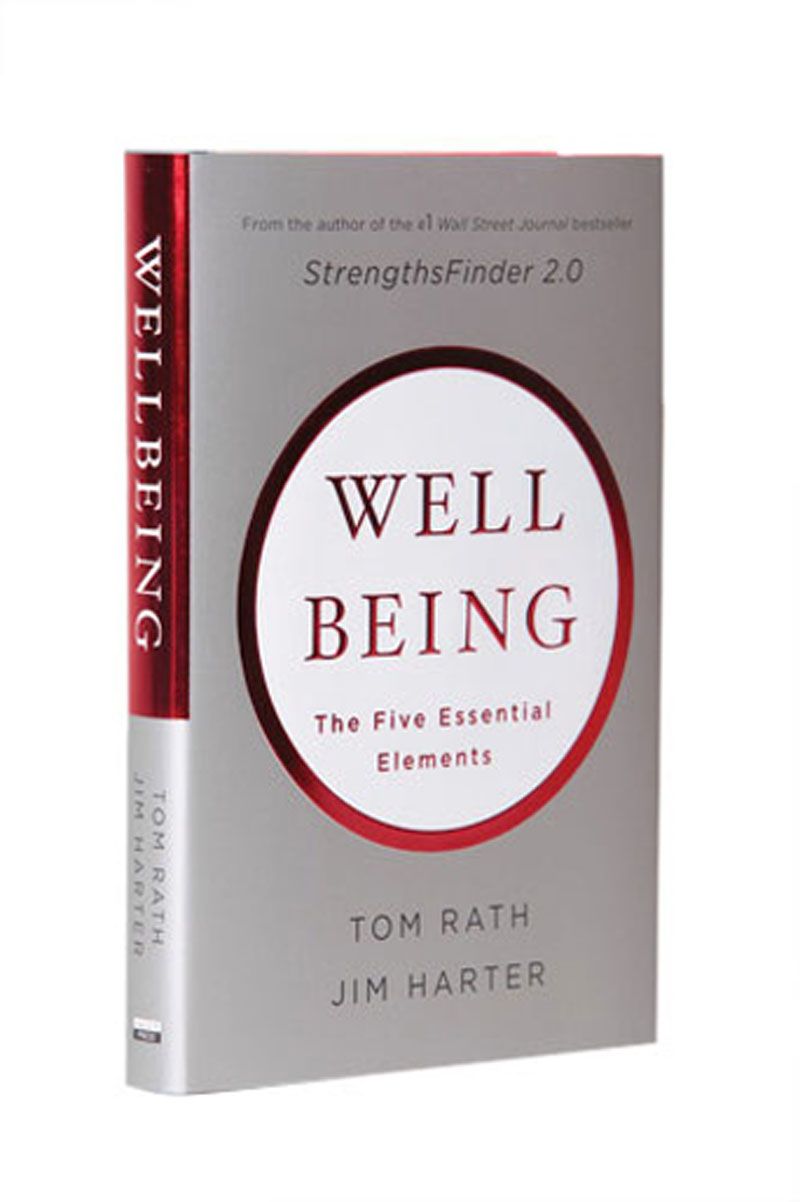
Enjoy each day and get more out of your life!
When striving to improve our lives, we’re quick to buy into programs that promise to help us make money, lose weight, or strengthen our relationships.
While it might be easier to treat these critical areas in our lives as if they are independent, they’re not. Gallup’s comprehensive study of people in more than 150 countries revealed five universal, interconnected elements that shape our lives: Career Wellbeing, Social Wellbeing, Financial Wellbeing, Physical Wellbeing, and Community Wellbeing.
Their groundbreaking research reveals how organizations can help employees boost their overall wellbeing — from their satisfaction with their careers to their financial security and level of community involvement. After conducting this extensive study, Rath and Harter discovered that much of what we think will improve our wellbeing is either misguided or just plain wrong.
Wellbeing: The Five Essential Elements provides you with a holistic view of what contributes to your wellbeing over a lifetime. Written by #1 New York Times bestselling author Tom Rath and bestselling author Jim Harter, Ph.D., this book is filled with fascinating research and innovative ideas for boosting your wellbeing in each of these five areas.
By the time you finish reading this book, you’ll have a better understanding of what makes life worthwhile. This will enable you to enjoy each day and get more out of your life – while boosting the wellbeing of your friends, family members, colleagues, and others in your community.
About the authors


Tom Rath has written three international bestsellers in the last decade. His first book, How Full Is Your Bucket, was a #1 New York bestseller. Rath’s book StrengthsFinder 2.0 is a long-running #1 Wall Street Journal bestseller and was listed by USA TODAY as the top-selling business book of 2008. In total, Rath’s books sold more than 2 million copies in the U.S. alone and have made more than 100 appearances on the Wall Street Journal bestseller list.
Jim Harter, PhD., is Chief Scientist for Gallup’s international workplace management and wellbeing practices. He coauthored the New York Times bestseller: The Elements of Great Managing, which is based on the largest worldwide study of employee engagement. Since joining Gallup in 1985, Harter has coauthored more than 1,000 research studies, which have been reported on in bestselling management books and publications such as The Wall Street Journal, The New York Times, and USA TODAY.
YOUR WELLBEING

Much of what we think will improve our wellbeing is either misguided or just plain wrong.
Contrary to what many people believe, wellbeing isn’t just about being happy. Nor is it only about being wealthy or successful. And it’s certainly not limited to physical health and wellness. In fact, focusing on any of these elements in isolation could drive us to feelings of frustration and even failure.
We are quick to buy into programs that promise to help us make money, lose weight or strengthen our relationships. Then we spend the next few weeks dedicating our time and energy to that specific plan. Eventually, we give up on these programs when they conflict with other aspects of our lives.
If you’ve purchased books, watched videos, or attended classes on topics like these, you might have noticed how an intense focus on one area can actually be detrimental to your overall wellbeing. Just think how many people dedicate an excessive amount of time and energy to their job at the expense of their personal relationships. It might seem easier to treat the critical areas in our lives as if they are independent and unrelated, but they’re not. They are interdependent.
Wellbeing is about the combination of our love for what we do each day, the quality of our relationships, the security of our finances, the vibrancy of our physical health, and the pride we take in what we have contributed to our communities. Most importantly, it’s about how these five elements interact.
WHAT MAKES LIFE WORTHWHILE?
Gallup scientists have been exploring the demands of a life well-lived since the mid-20th century. More recently, in partnership with leading economists, psychologists, and other acclaimed scientists, the authors began to explore the common elements of wellbeing that transcend countries and cultures.
As part of this research, Gallup conducted a comprehensive global study of more than 150 countries, giving us a lens into the wellbeing of more than 98 percent of the world’s population. From Afghanistan to Zimbabwe, the study asked hundreds of questions about health, wealth, relationships, jobs, and communities. The authors then compared these results to how people experience their days and evaluate their lives overall.
In the authors’ initial research, they asked people what “the best possible future” for them would look like. They found that when evaluating their lives, people often give disproportionate weight to income and health. Perhaps this is because these things are easy to measure and track over time – we can monitor our height, weight, blood pressure, and household income. Yet we do not have a standard way to measure the quality of our careers or the health of our relationships.
So to construct a comprehensive measure of individual wellbeing, Gallup designed an assessment of the best questions they have asked over the last 50 years. To create this assessment, they tested hundreds of questions across countries, languages, and vastly different life situations.
Upon completion of the research, five distinct statistical factors emerged. These are the universal elements of wellbeing that differentiate a thriving life from one spent suffering. They describe aspects of our lives that we can do something about and that are important to people in every situation.
THE FIVE ESSENTIAL ELEMENTS
These elements are the currency of a life that matters. They do not include every nuance of what’s important in life, but they do represent five broad categories that are essential to most people.
- The first element is about how you occupy your time or simply liking what you do every day: your Career Wellbeing.
- The second element is about having strong relationships and love in your life: your Social Wellbeing.
- The third element is about effectively managing your economic life: your Financial Wellbeing.
- The fourth element is about having good health and enough energy to get things done on a daily basis: your Physical Wellbeing.
- The fifth element is about the sense of engagement you have with the area where you live: your Community Wellbeing.
Just 66% of people are doing well in at least one of these areas, just 7% are thriving in all five. If we’re struggling in any of these domains, as most of us are, it damages our wellbeing and wears on our daily life. When we strengthen our wellbeing in any of these areas, we will have better days, months, and decades. But we’re not getting the most of our lives unless we’re living effectively in all five.
These five elements are universal across faiths, cultures, and nationalities.
There are many ways to create thriving Career, Social, Financial, Physical and Community Wellbeing. Because these critical elements are within our control, we have the ability to improve them (for example, exercising, spending more time with friends, or using money wisely). However, the single biggest threat to our own wellbeing is ourselves. Without even giving it much thought, we allow our short-term decisions to override what’s best for our long-term wellbeing.
As long as we allow our short-term desires to win, it will be difficult to effect long-term behavioral change. However, the authors learned from people with the highest levels of wellbeing that there is a simple solution to this problem: If we can find short-term incentives that are consistent with our long-term objectives, it is much easier to make the right decisions in the moment.
For example, we might choose to exercise tomorrow because we know that just 20 minutes of activity can boost our mood for the next 12 hours. Or we are more likely to skip a cheeseburger and fries when we consider the short-term reality that devouring it will lead to a “fat hangover” that ruins the rest of our day.
When we see an immediate payoff, we are more likely to change our behavior in the moment. This aligns our daily actions with our long-term interests. So wanting more energy throughout the day (short-term incentive) leads to exercising 20 minutes each morning (a better decision in the moment), and this eventually leads to avoiding chronic health issues (the long-term objective).
Setting these “positive defaults” and making even small changes to our daily routines can have a major and lasting impact to our wellbeing.
1. CAREER WELLBEING
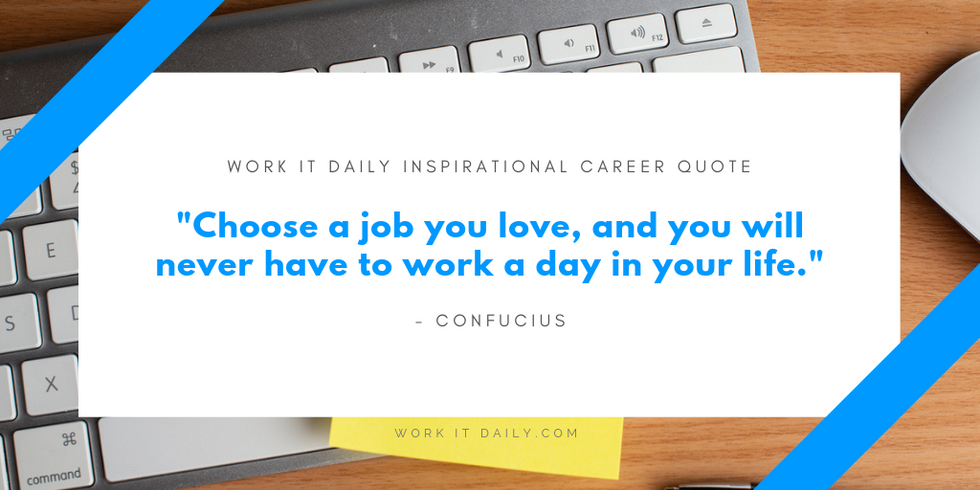
Do you like what you do each day?
This might be the most basic, yet important, wellbeing question we ask ourselves. Yet only 20% of people can give a strong “yes” in response.
At a fundamental level, we all need something to do, and ideally something to look forward to, when we wake up every day. What you spend your time doing each day shapes your identity.
We spend the majority of our waking hours during the week doing something we consider a career, occupation, vocation, or job. When people first meet, they ask each other, “What do you do?” If your answer to that question is something you find fulfilling and meaningful, you are likely thriving in Career Wellbeing.

People usually underestimate the influence of their career on their overall wellbeing. But Career Wellbeing is arguably the most essential of the five elements. If you don’t have the opportunity to regularly do something you enjoy – the odds of your having high wellbeing in other areas diminish rapidly. People with high Career Wellbeing are more than twice as likely to be thriving in their lives overall.
Imagine that you have great social relationships, financial security, and good physical health – but you don’t like what you do every day. Chances are, much of your social time is spent worrying or complaining about your lousy job. And this causes stress, taking a toll on your physical health. If your Career Wellbeing is low, it’s easy to see how it can cause deterioration in other areas over time.
ENGAGEMENT AT WORK
The authors explored the differences in momentary experiences between working and nonworking days. They found that engaged workers has similar happiness levels on working and nonworking days, with only slight increases in stress and a positive boost in interest levels when they are at work. However, disengaged workers experienced dramatic drops in interest and happiness – as well as major increases in stress – during working days.
For those who are engaged, a day at work might be slightly more stressful than the weekend, but that is offset by normal levels of happiness and even more interest when they are at work. However, disengaged workers live for the weekend and dread the workday. So if your Career Wellbeing is thriving, you are also able to have good weekends and good weekdays, and the time you are at work is as enjoyable as the time you spend away from work.
This was one of the patterns the authors observed among people with thriving Career Wellbeing: They love their work so much that it is closely aligned with – and can’t help but spill over into – their personal lives.
USING YOUR STRENGTHS
So many lives – and in some cases, entire cultures – are built around the premise that work is something that we are not supposed to enjoy. This fundamentally flawed perception is woven into societies and economic models around the world. As a result, people strive to minimize the number of hours they need to work in a day or week, and they try to retire as early as possible. Then paradoxically, as they near “retirement age,” they realize how dull life would be if they were not working at all. According to one study, by the time people reach their 50s, nearly two-thirds want to keep working.
One of the essentials to having fun at work is getting the opportunity to use your strengths every day. When we build on our strengths and daily successes – instead of focusing on failures – we simply learn more.
Compared to those who do not get to focus on what they do best, people who have the opportunity to use their strengths are six times as likely to be engaged in their jobs and more than three times as likely to report having an excellent quality of life. The authors’ global data show that these people can enjoy a full 40-hour workweek, while those who do not get to use their strengths get burned out after just 20 hours of work per week.
THE ESSENTIALS OF CAREER WELLBEING
People with Career Wellbeing wake up every morning with something to look forward to doing that day. They have the opportunity to use their strengths each day and make progress. Those with thriving Career Wellbeing have a deep purpose in life and a plan to attain their goals. In most cases, they have a leader or manager who makes them enthusiastic about the future and friends who share their passion.
RECOMMENDATIONS FOR BOOSTING YOUR CAREER WELLBEING:
- Every day, use your strengths.
- Identify someone with a shared mission who encourages your growth. Spend more time with this person.
- Opt into more social time with the people and teams you enjoy being around at work.
2. SOCIAL WELLBEING
When you reflect on the more memorable events, experiences, and moments in your life, you’ll notice that they have something in common: the presence of another person. The best moments – and most agonizing ones – occur at the intersection between two people. Yet we often underestimate the impact of our closest relationships and social connections.
Scientists are discovering how relationships shape our expectations, desires, and goals. Emotions spread quickly from one person to the next. Because we tend to synchronize our moods with the people around us, our emotions influence one another throughout the day.
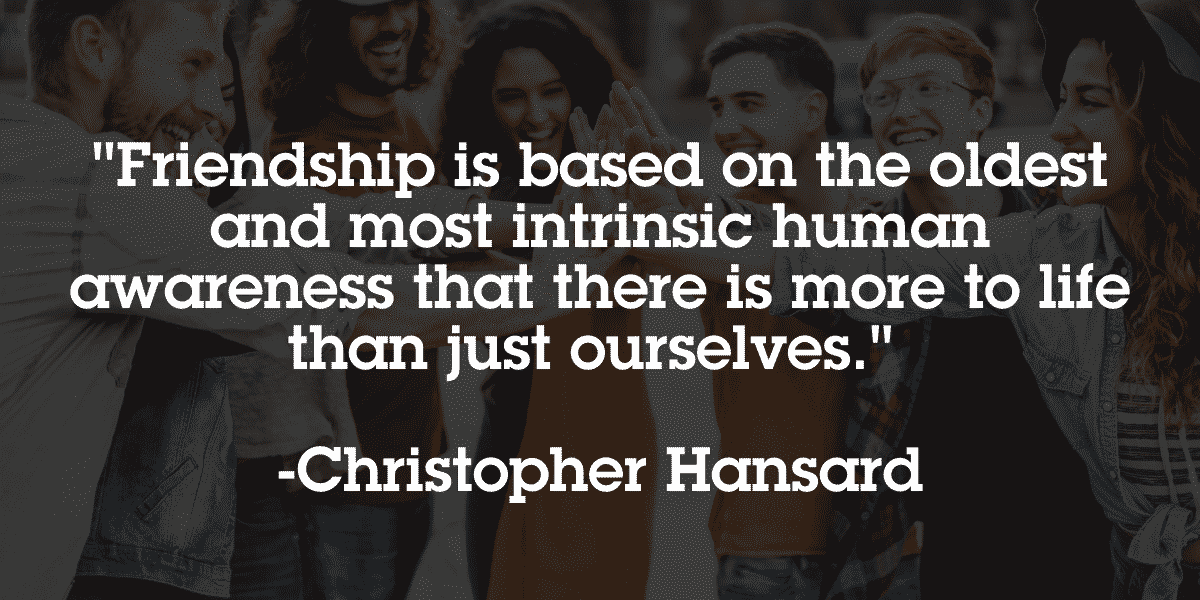
DO WE INHERIT MORE FROM FRIENDS THAN FROM FAMILY?
Not only do people directly around us influence our wellbeing, so does our friends’ independent network of relationships. According to a Harvard study, our wellbeing is dependent on our entire network. In other words, having direct and frequent social contact with someone who has high wellbeing dramatically boosts your chances of being happy.
SOCIAL TIME KEEPS STRESS AWAY
In addition to close relationships and proximity, the sheer amount of time we spend socializing matters. The data suggest that to have a thriving day, we need six hours of social time. When we get at least six hours of daily social time, it increases our wellbeing and minimize stress and worry. Just so you don’t think that six hours of social time is unattainable in one day, it’s important to note that the six hours includes time at work, at home, on the phone, talking to friends, sending e-mail, and other communication.
When people have almost no social time in a given day, they have equal chance of having a good day or bad day. However, each hour of social time quickly decreases the odds of having a bad day. Even three hours of social time reduces the chances of having a bad day to 10%. And each additional hour of social time – up to about six hours – improves the odds of having a good day.
Beyond the immediate increase in wellbeing that comes with each hour of social time, the long-term benefits can be even more profound, particularly as we age. A study of more than 15,000 people over the age of 50 found that among those who were socially active, their memories declined at less than half the rate compared to those who were the least social.
WITHOUT A FRIEND, WORK IS LONELY
Gallup has conducted extensive studies on the value of friendships in the workplace. One of the most revealing questions the studies asked more than 15 million employees all over the world is whether they have a best friend at work. The studies used this specific wording because early research indicated that having a best friend at work was a more powerful predictor of workplace outcomes than simply having a “friend” or even a “good friend.”
The research revealed that just 30% of employees have a best friend at work. Engaging customers, produce higher quality work, have higher wellbeing, and are less likely to get injured on the job. In sharp contrast, those without a best friend in the workplace have just a 1 in 12 chance of being engaged.
RECOMMENDATIONS FOR BOOSTING SOCIAL WELLBEING
- Spend six hours a day socializing with friends, family, and colleagues (this time includes work, home, phone, e-mail, and other communication.
- Strengthen the mutual connections in your network.
- Mix social time with physical activity. For example, take a long walk with a friend so you can motivate each other to be healthy.
3. FINANCIAL WELLBEING
As the authors studied a great deal on the topic of money and its importance in our lives, what they found challenged many of their assumptions. Advice from financial gurus wasn’t holding up. Nor was a central tenet of classic economics, in which the assumption is that people make rational decisions that result in optimal monetary gain. Most strikingly, they learned that the amount of money you have – the gold standard for measuring financial health – is not the best gauge of your Financial Wellbeing, let alone your life in general.

DO YOU NEED MONEY TO BE HAPPY?
It would be nice to believe that we all have the same opportunity to be happy, regardless of our income level. But the authors’ data suggest that this is false. Based on a comprehensive study using Gallup wellbeing data from 132 countries, there is undoubtedly a relationship between wellbeing and Gross Domestic Product (GDP) per capita – and the connection is much stronger than the authors have guessed. Clearly, wealthier countries have citizens with higher wellbeing. So although money doesn’t guarantee happiness, being in a wealthy country increases your odds of having a good life.
In lower income countries, pain is one of the leading causes of suffering. And having the money to pay for basic healthcare can improve wellbeing through the alleviation of physical pain. So for a great number of people around the world, money is absolutely essential for meeting basic needs.
HOW YOU CAN BUY WELLBEING
When a team of Harvard researchers surveyed people about their time spending on themselves, their spending on others, and their happiness, they found that spending on oneself does not boost happiness. However, spending money on others does – and it appears to be as important to people’s happiness as the total amount of money they make.
In another experiment, the same investigators studied people who had recently received a large sum of “bonus” money from their organization’s profit-sharing program and tracked how each person chose to spend his money. As you might expect, some people spent their money on personal items such as bills, expenses, rent, mortgage, or material goods. Others spent extra money on something for another person or donated money to charity. Again, spending money on oneself didn’t boost happiness, while spending the money on others did.
SPENDING ON EXPERIENCES AND MEMORIES
Buying experiences such as going out to dinner or taking a vacation increases our own wellbeing and the wellbeing of others. Experiences last while material purchases fade. Even if you feel better immediately after your purchase, studies show that our satisfaction with material goods decreases over time.
But if we use our money to buy pleasant experiences, we get the benefit of looking forward to the event, the actual experience, and in some cases, decades of fond memories. Material items lose their novelty, but we can relive memories indefinitely.
IS WEALTH ACCUMULATION THE WRONG TARGET?
Income, debt, and net worth are some of the most common metrics we use to evaluate the overall health of our finances. Yet people with thriving Financial Wellbeing talk about a general sense of financial security (and lack of worry) instead of these absolute measures of wealth. So after reviewing the levels of income of the people interviewed during the study, the authors conducted a deeper analysis of the key drivers of Financial Wellbeing.
What the authors found was that financial security – the perception that you have more than enough money to do what you want to do – has three times the impact of your income alone on overall wellbeing.
Bookstore shelves are lined up with advice about how to become rich, and most financial advisors are judged based on the monetary return they deliver. But this might be targeting the wrong outcome.
Focusing solely on this goal can even reduce our wellbeing. There are plenty of people who make a lot of money but don’t feel financially secure, and they worry about money regularly, which in turn drains their wellbeing. Conversely, there are lots of people with lower income who do feel financially secure and worry very little about money, which builds up their wellbeing.
INVESTING MINIMIZE STRESS
People with thriving Financial Wellbeing are satisfied with their standard of living, don’t worry about money in their everyday lives, and have confidence in their financial future.
When a wealth-accumulation strategy creates daily stress, it’s not worth the potential return. If a major purchase such as a home or a car creates a burden that makes you uncomfortable, it’s likely to more damage than good for your overall wellbeing. In short, managing your finances well allow you to do what you want to do when you want to do it.
THE ESSENTIALS OF FINANCIAL WELLBEING
People with thriving Financial Wellbeing are satisfied with their overall standard of living. They manage their personal finances well to create financial security. This eliminates day-to-day stress caused by debt and helps people build financial reserves. People with high Financial Wellbeing spend their money wisely. They buy experiences that provide them with lasting memories. They give to others and don’t just spend on themselves. As a result of managing their money wisely, they have the financial freedom to spend even more time with the people whose company they enjoy most.
RECOMMENDATIONS FOR BOOSTING FINANCIAL WELLBEING
- Buy experiences — such as vacations and outings with friends or loved ones.
- Spend on others instead of solely on material possessions.
- Establish defaults (automated savings and payments ) that lessen daily worry about money.
4. PHYSICAL WELLBEING
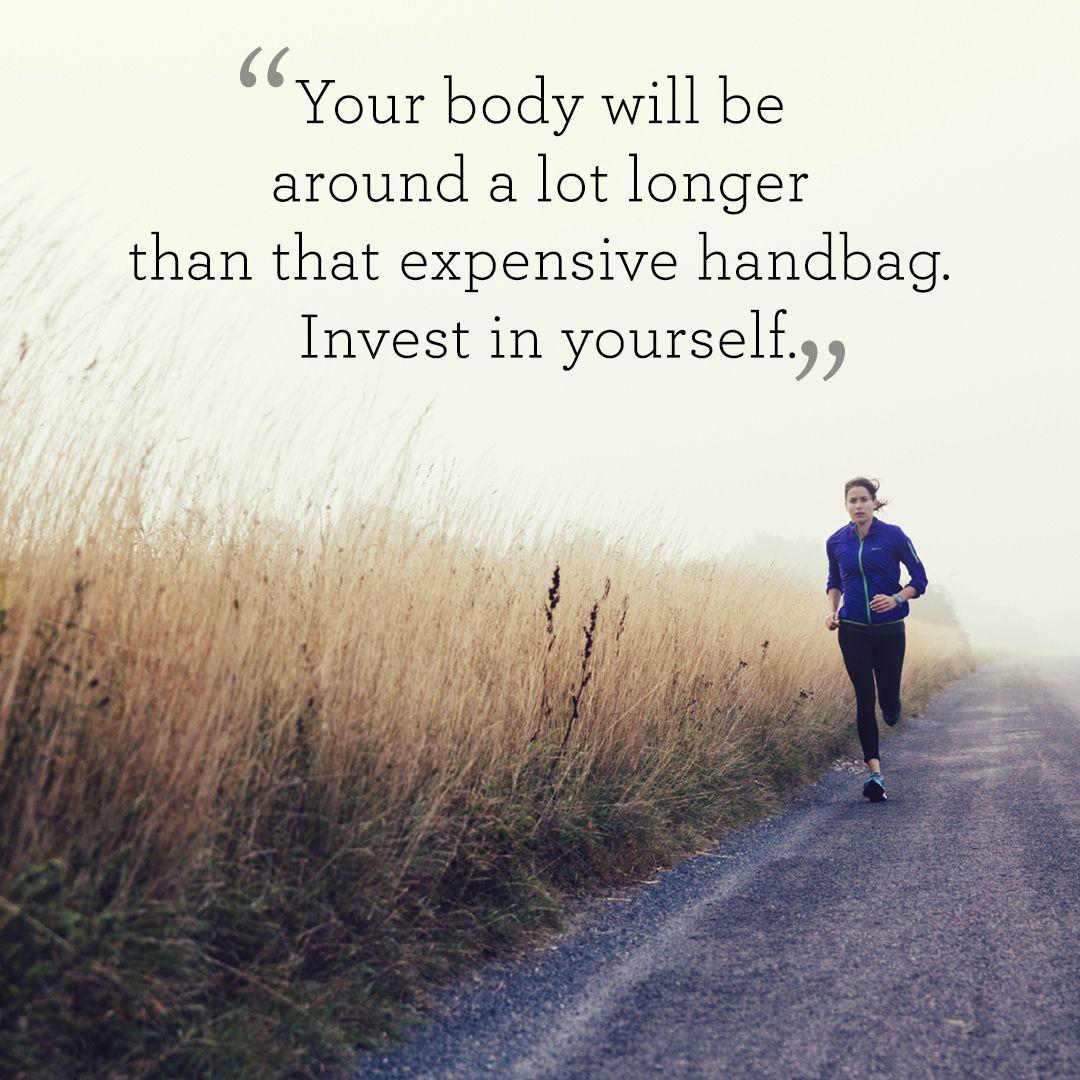
With every food and drink we take, we make a choice: We can select something that is a net positive and benefits our health or we can choose something that is net negative that is bad for our health.
There are hundreds of moments every week when we make these seemingly small – but eventually significant – decisions. When we make a net positive choice (e.g., ordering salmon with a side of broccoli), it can improve our mood for the rest of the day – and in the long term, reduce our chances of getting diabetes, heart disease, and cancer. When we make a net negative choice (e.g., ordering cheeseburger and fries), it can decrease our energy for the rest of the day – and over the years, raise our glucose and cholesterol levels.
If we choose a balance of good and bad foods, paired with a moderate amount of sleep and exercise, our body runs closer to average. But if we make substantially net positive decisions, about what we eat and drink, coupled with a good night’s sleep our bodies will run much more efficiently.
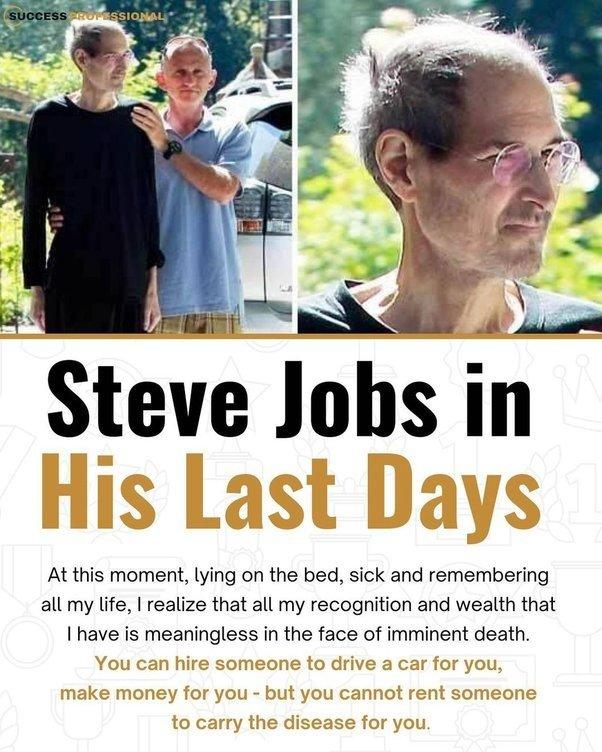
POSITIVE DEFAULTS TO YOUR HEALTH
Making the right choices in advance can help us get ahead of our short-term desires. For example, if we’re able to make healthy choices in the supermarket, it is easier to control impulse-eating when we open the refrigerator. Even when making minor decisions such as where to go for lunch, the restaurant we choose might be more important than the decision we make when we order at the restaurant. Fewer than 1 in 10 people even claim to be good at resisting the temptation of unhealthy options on a menu.
If we choose to have lunch at a restaurant that serves mostly healthy choices, it increases our odds of making a good decision. Or if we prepare a nutritious lunch in advance and take it to work, that circumvents both of these opportunities for our short term self to take over. The further we can get ahead of our immediate impulses by doing things like loading up on healthy foods at the grocery store, the more we boost our odds of making a healthy decision.
THE ESSENTIALS OF PHYSICAL WELLBEING
People with thriving Physical Wellbeing effectively manage their health. They exercise regularly and feel better throughout the day as a result. They make good dietary choices, which keeps their energy high throughout the day and sharpens their thinking. They get enough sleep to wake up feeling well-rested and to process what they learned the day before – and to get a good start on the next day. People with thriving Physical Wellbeing makes you look better, feel better, and live longer.
RECOMMENDATIONS FOR BOOSTING PHYSICAL WELLBEING
- Get at least 20 minutes of physical activity each day — ideally in the morning to improve your mood throughout the day.
- Sleep well enough to feel well-rested (generally 7 to 8 hours).
- Set positive defaults when you shop for groceries. Load up on natural foods.
5. COMMUNITY WELLBEING
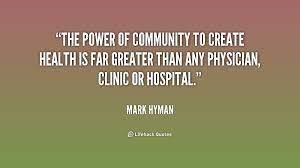
Community Wellbeing is not the first thing people think about when they evaluate their overall wellbeing. But this element can actually be the differentiator between a good life and a great one.
Community Wellbeing starts with some of the basics. While you might not think of the quality of water you drink or the air you breathe every day, a lack of security about these fundamental needs can cause significant concern over time. Feeling safe walking alone at night in your neighborhood and having confidence that you will not be harmed or assaulted is another primary necessity.
In countries around the world – particularly in developing nations – millions of people report that they do not have this security. Even in the U.S., England, France, Germany and Australia, as many as one in three people don’t feel safe walking alone at night where they live. When these needs are not met, it is difficult to have thriving wellbeing.
THE PERFECT PLACE FOR YOU
Once you have a basic sense of security, the next level of Community Wellbeing is living in an area that is a good fit for your personality, family, interests, and other pursuits. John, who has a thriving Community Wellbeing, described his city this way, “It’s a little slower paced than your average city. Very outdoorsy. If you like outdoor activities, this is a good place. Clean, good schools, and you can feel safe walking around any time of day or night, and the cost of living is a lot cheaper here than when we were previously.”
While the things that make a community “perfect” will be different for everyone, people use common themes to describe ideal communities.
- One of the most important factors is aesthetics, which includes naturally beautiful places and the availability of parks, trails, and playgrounds.
- Another key differentiator is social offerings, or places where people meet, spend time with friends, and enjoy the nightlife.
- The third quality that distinguishes near-perfect communities from the rest is a general openness to all types of people, regardless of race, heritage, age, or sexual orientation.
However, just living in the right place is unlikely to create thriving Community Wellbeing. This requires active involvement in community groups or organizations. Participating in outreach programs to clean up the community, feed those in need, or help children learn fosters their Community Wellbeing.
Unless you make an effort to get involved in social groups, it is unlikely that your Community Wellbeing will grow. Many people claim to live in strong communities, but they acknowledge that they like to keep to themselves – and as a result, most of these people have lower Community Wellbeing. Even for those who are not naturally sociable, just signing up, opting into an event, or initiating some contract with community groups can boost overall wellbeing.
Thriving Community Wellbeing is about what we do to give back to our community.
WELL-DOING – THE PINNACLE OF A LIFE WELL-LIVED
“Give blood. All you’ll feel is good.”
As this slogan from an American Red Cross campaign illustrates, giving is good for both recipient and the donor. Psychologists have conducted experiments to determine if the Red Cross claim is true – and it turns out that this is one slogan that passes the truth-in-advertising test. People reported experiencing increased moods before and after they donated blood.
At the highest end of Community Wellbeing is giving back to society. This may be what differentiates an exceptional life from a good one. When the authors asked people with thriving wellbeing about the greatest contribution they had made in their life, with few exceptions, they mentioned the impact they have had on another person, group, or community. Not only had these individuals made a substantial contribution to something bigger than themselves, but they also had been recognized for their community involvement.
We often get a sense of joy from giving a meaningful gift to a loved one, but perhaps no gift is as valuable as our time. This explains why some volunteers get a “helper’s high” – they feel stronger, more energetic, and more motivated after helping others even in the smallest ways. When the study surveyed more than 23,000 people on this topic, nearly 9 in 10 reported “getting an emotional boost” from doing these kind things for other people.
When we do things for others, we see how we can make a difference in our own ability to create change. Throughout the course of our lives, well-doing promotes deeper social interaction, enhanced meaning and purpose, and a more active lifestyle – while keeping us from being too preoccupied with ourselves or getting into harmful emotional states. Several studies have shown a link between altruistic behavior and increases in overall longevity. Researchers have speculated that this might be due in part to how well-doing inoculates us against stress and negative emotions.
INCREASING WELLBEING THROUGHOUT YOUR COMMUNITY
Major social changes like the decline in smoking rates driven by peer pressure occur in the context of social networks. Most people did not quit smoking on their own. They quit because it was no longer socially acceptable to smoke. Their friends quit, local restaurants banned them from smoking, and their employers literally pushed them to quit. As smokers were pushed to the outer edges of their communities, they finally kicked the habit.
This is just one example of how groups, communities, and organizations can create positive social change. Alcoholics Anonymous leverages relationships and fosters positive group pressure to help people stay sober. Weight Watchers brings people together to lose weight. These efforts are successful, in large part, because they draw on positive peer pressure, social support, and accountability to others.
Experimental research suggests that creating sustainable change may be two to three times as likely to happen in the context of a group, company, or community organization. For example, if you enroll in an intensive weight-loss program alone, there is a 24% chance that you will maintain the same program and then join a social support group of three strangers, there is a nearly 50% chance you will maintain the weight loss 10 months later. But if you enroll in the program with three friends or colleagues you already know, the odds of maintaining your weight loss go up to 66%.
As part of the Gallup research, the researchers routinely asked people if they have volunteered in the past month. Across 150 countries, they found that people who are engaged in their careers are 20%-30% more likely to give back to their community. In one organization, they found that workers who were the most engaged in their jobs donated 2.6 times more than those who were not engaged in their careers. Community Wellbeing is interconnected with, and builds directly on, the other four elements. So as your wellbeing improves in other areas, your odds of having a thriving Community Wellbeing dramatically increases as well.
THE ESSENTIALS OF COMMUNITY WELLBEING
People with high Community Wellbeing feel safe and secure where they live. They take pride in their community, and they believe it is headed in the right direction. This often results in their wanting to give back and make a lasting contribution to society. People with thriving Community Wellbeing have identified areas where they can contribute to their community based on their own strengths and passions. They tell others about these interests to connect with the right people and causes. Their contribution may start small, but over time, it leads to more involvement and has a profound impact on their community. The efforts of people with Community Wellbeing are what create communities we cannot imagine living without.
RECOMMENDATIONS FOR BOOSTING COMMUNITY WELLBEING
- Identify how you can contribute to your community based on your personal mission.
- Tell people about your passions and interests so they can connect you with relevant groups and causes.
- Opt in to a community group or event. Even if you start small, start now.
MEASURING WHAT MAKES LIFE WORTHWHILE
As Bobby Kennedy said in 1968, we continue to gauge the progress of our lives, our organizations, and our communities based on narrow and shallow measures:
“We seem to have surrendered community excellence and community values in the mere accumulation of material things…Yet the gross domestic product does not allow for the health of our children, the quality of their education, or the joy of their play. It does not include the beauty of our poetry or the strength of our marriages; the intelligence of our public debate or the integrity of our public officials. It measures neither wit nor courage; neither our wisdom nor our learning; neither our compassion nor our devotion to our country; it measures everything, in short, except that which makes life worthwhile.”
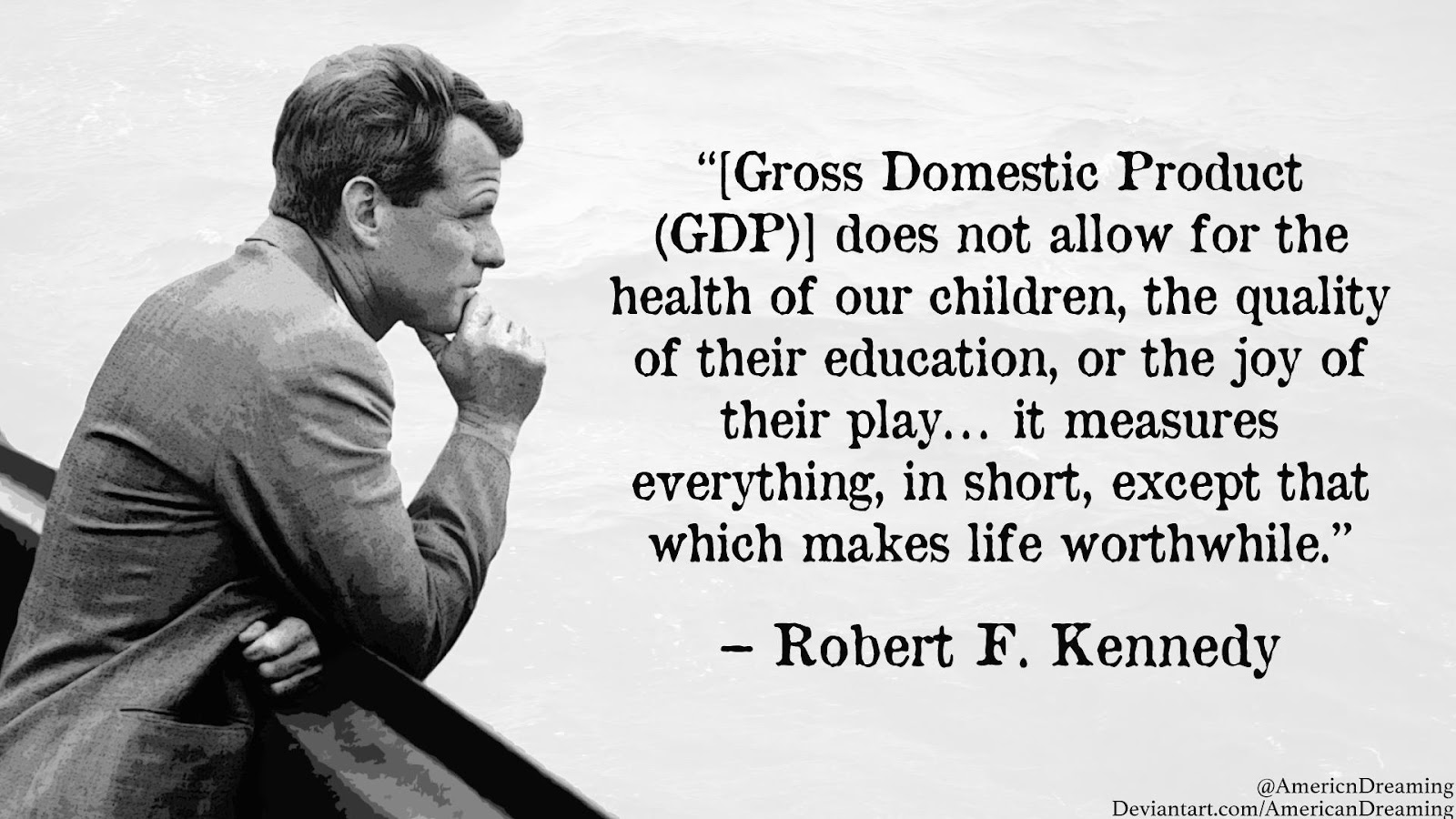
As Kennedy eloquently described, our lives are the composite of much more than our economic output. To create a life that’s worthwhile, not just for ourselves but for those around us, we need to find something we love to do that benefits society. We need to invest time strengthening our relationships with the people we love. We need enough financial security to provide for our families’ needs. We need to adopt lifestyles that give us health and energy to keep moving each day.
On a given day, we might sit around and respond to problems at work instead of initiating. We might possibly watch TV instead of exercising. Or maybe we spend on something now that creates stress in a few weeks or months. We might even think about doing something to give back to our community, but decide we’ll do it later and never get around to it. Days like this start a vicious cycle.
Just one day when we eat poorly, skip exercising, are stressed at work, don’t get enough social time, and worry about money leads to a host of negative outcomes. On days like this, we have less energy, we look worse, we don’t treat people well, and get a lousy night’s sleep. As a result, we miss the reset provided by a sound night of sleep, and the cycle continues.
When we break this downward spiral and get a good night’s sleep, we’re off to the right start. This allows us to wake up refreshed and increases our chance of exercising in the morning. If we can use our strengths at our job every day, this connects our daily activities to a much higher purpose and allows us to get more done. Between our work and time with our family and friends, if we can get six hours of social time, chances are, we’ll have 10 times as many good moments as stressful ones.
One of the best ways to create more good days is by setting positive defaults.
Anytime you help your short-term self work with your long-term self, you have an opportunity. You can intentionally choose to spend more time with the people you enjoy most and engage your strengths as much as possible. You can structure your finances to minimize the worry caused by debt. You can make exercise a standard part of your routine. You can make healthier decisions in the supermarket. And you can make commitments to community, religious, or volunteer groups, knowing that you will follow through once you’ve signed in advance.
Through these daily choices, you create stronger friendships, families, workplaces, and communities.
/// end
University of Experience is a special Aboitiz Eyes section that focuses on leadership insights from the unique experiences, perspectives, and wisdom of leaders who have stood at the helm of Aboitiz over the years.
If you enjoyed this article, would like to suggest a topic, or simply share your feedback, please CLICK HERE.

